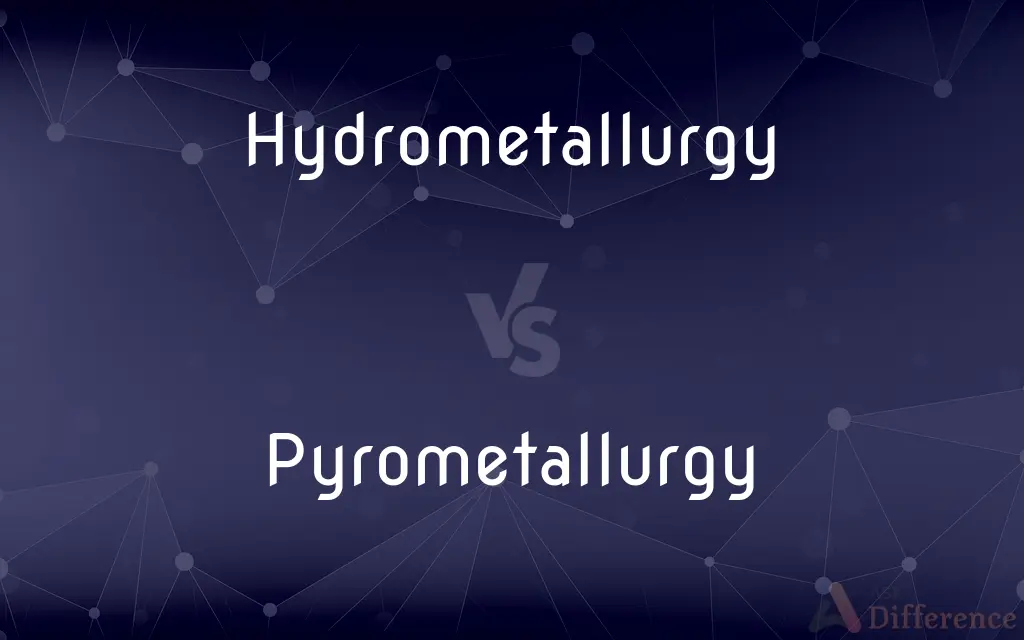Hydrometallurgy vs. Pyrometallurgy — What's the Difference?
By Tayyaba Rehman & Urooj Arif — Updated on May 7, 2024
Hydrometallurgy involves using aqueous chemistry to extract metals, while pyrometallurgy relies on high temperatures for metal processing.

Difference Between Hydrometallurgy and Pyrometallurgy
Table of Contents
ADVERTISEMENT
Key Differences
Hydrometallurgy uses chemical solutions to dissolve metals from their ores and involves processes like leaching, precipitation, and solvent extraction. Pyrometallurgy, on the other hand, uses high temperatures to melt and refine metals through processes like roasting, smelting, and refining.
Hydrometallurgy is particularly advantageous for low-grade ores or complex ores that are difficult to process with high heat. Pyrometallurgy is better suited for higher-grade ores due to its efficiency in quickly processing large amounts of material.
While hydrometallurgy generally requires more time for the chemical reactions to occur, pyrometallurgy is faster but consumes more energy because of the high temperatures needed.
Hydrometallurgy is considered environmentally friendlier due to lower emissions, whereas pyrometallurgy can lead to higher pollution unless proper emission controls are implemented.
In terms of applications, hydrometallurgy is often used for extracting metals like copper, gold, and uranium, while pyrometallurgy is used extensively for iron, steel, and aluminum production.
ADVERTISEMENT
Comparison Chart
Process Type
Aqueous chemistry
High-temperature heat processing
Key Techniques
Leaching, precipitation, solvent extraction
Roasting, smelting, refining
Energy Requirement
Relatively lower
Higher due to intense heating
Environmental Impact
Typically lower emissions
Higher emissions without control
Application
Copper, gold, uranium extraction
Iron, steel, aluminum production
Compare with Definitions
Hydrometallurgy
Extraction of metals from ores using aqueous chemical processes.
The plant relies on hydrometallurgy to extract copper from low-grade ores.
Pyrometallurgy
Heating of ores to drive chemical reactions.
Roasting is a pyrometallurgical process to eliminate impurities.
Hydrometallurgy
Leaching of metal-bearing ores to obtain dissolved metal ions.
Leaching is a critical step in hydrometallurgy to obtain dissolved gold.
Pyrometallurgy
Metal extraction using high-temperature heat treatment.
The foundry employs pyrometallurgy to smelt iron ores into steel.
Hydrometallurgy
Precipitation of metals from a chemical solution.
Precipitation separates the metal from its solution in hydrometallurgy.
Pyrometallurgy
Smelting or melting ores to separate valuable metals.
Smelting is used in pyrometallurgy to extract copper.
Hydrometallurgy
Use of aqueous solutions for separating valuable metals.
Hydrometallurgy employs aqueous solutions to separate rare earth metals.
Pyrometallurgy
High-temperature processing in the production of metals.
Pyrometallurgy is common in industrial aluminum and steel production.
Hydrometallurgy
Application of solvent extraction for purification.
Solvent extraction is used to refine uranium during hydrometallurgy.
Pyrometallurgy
Refining of metals through heat-based chemical reactions.
Pyrometallurgy relies on refining methods to purify aluminum.
Hydrometallurgy
Hydrometallurgy is a technique within the field of extractive metallurgy, the obtaining of metals from their ores. Hydrometallurgy involve the use of aqueous solutions for the recovery of metals from ores, concentrates, and recycled or residual materials.
Pyrometallurgy
Pyrometallurgy is a branch of extractive metallurgy. It consists of the thermal treatment of minerals and metallurgical ores and concentrates to bring about physical and chemical transformations in the materials to enable recovery of valuable metals.
Hydrometallurgy
The treatment of metal or the separation of metal from ores and ore concentrates by liquid processes, such as leaching, extraction, and precipitation.
Pyrometallurgy
An ore-refining process, such as smelting, dependent on the action of heat.
Hydrometallurgy
The field of extractive metallurgy involving the use of aqueous chemistry for the recovery of metals from ores, concentrates, and recycled or residual materials.
Pyrometallurgy
Any process that uses high temperatures to transform either metals or their ores.
Hydrometallurgy
The art or process of assaying or reducing ores by means of liquid reagents.
Common Curiosities
Which method is more environmentally friendly?
Hydrometallurgy generally has a lower environmental impact due to fewer emissions compared to pyrometallurgy.
What are the main processes in pyrometallurgy?
Key pyrometallurgical processes include roasting, smelting, and refining.
What is the main difference between hydrometallurgy and pyrometallurgy?
Hydrometallurgy uses aqueous chemical solutions, while pyrometallurgy relies on high-temperature processes.
Which method is more energy-efficient?
Hydrometallurgy is generally more energy-efficient because it uses chemical processes rather than intense heat.
Can low-grade ores be processed through pyrometallurgy?
Yes, but hydrometallurgy is often preferred for low-grade ores due to its more effective chemical dissolution.
What is roasting in pyrometallurgy?
Roasting involves heating ores in the presence of oxygen to convert sulfides into oxides.
What does leaching mean in hydrometallurgy?
Leaching is the process of dissolving metals from ores using chemical solutions.
What metals are commonly extracted using hydrometallurgy?
Copper, gold, and uranium are frequently extracted using hydrometallurgy.
Are there any disadvantages to using hydrometallurgy?
It can be slower and requires careful handling of chemicals.
Is pyrometallurgy suitable for all metal types?
No, it's better suited for metals that can withstand high temperatures, such as iron and aluminum.
Which method is faster in processing ores?
Pyrometallurgy is typically faster due to the rapid chemical changes induced by high heat.
How is solvent extraction used in hydrometallurgy?
Solvent extraction selectively separates and purifies dissolved metals from the solution.
Why is energy consumption higher in pyrometallurgy?
The need for sustained high temperatures requires a significant amount of energy in pyrometallurgy.
What are the primary advantages of hydrometallurgy?
It offers better metal recovery from low-grade ores and has a lower environmental impact.
Can pyrometallurgy be used for recycling metals?
Yes, pyrometallurgy is commonly used for metal recycling, particularly in steel and aluminum industries.
Share Your Discovery

Previous Comparison
Common vs. Normal
Next Comparison
Shawarma vs. FalafelAuthor Spotlight
Written by
Tayyaba RehmanTayyaba Rehman is a distinguished writer, currently serving as a primary contributor to askdifference.com. As a researcher in semantics and etymology, Tayyaba's passion for the complexity of languages and their distinctions has found a perfect home on the platform. Tayyaba delves into the intricacies of language, distinguishing between commonly confused words and phrases, thereby providing clarity for readers worldwide.
Co-written by
Urooj ArifUrooj is a skilled content writer at Ask Difference, known for her exceptional ability to simplify complex topics into engaging and informative content. With a passion for research and a flair for clear, concise writing, she consistently delivers articles that resonate with our diverse audience.











































